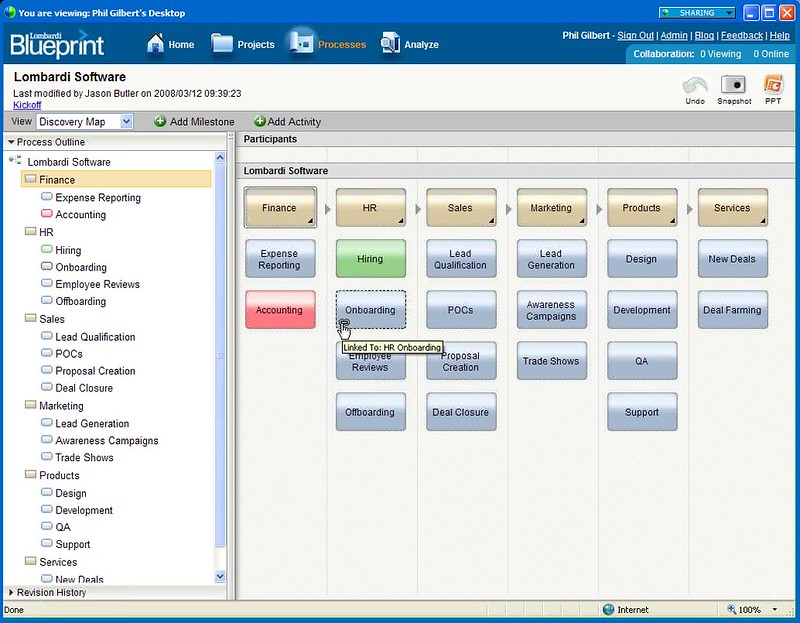I’m not sure what possessed Lombardi to hold their user conference in Austin in June — it’s going to 39C here today — but a couple of hundred customers have gathered for a couple of days about Lombardi’s products and the customers using them. There’s the usual difficulty in figuring out how to deal with new media, and I’ve been somewhat muzzled on giving the names of customers who are speaking here, although if you had half a brain, you could check the agenda and figure out who I’m referring to when I use the approved verbiage “a large US-based automotive company”. Of course, if there’s customers here who blog (or comment on blogs) or Twitter, then likely they haven’t been given the same explicit instructions, so no restrictions for them. 🙂
After a few opening remarks from Jim Rudden (who was kind enough to ask for my suggestions on what makes a conference great several months ago, and appears to have actually implemented several of them), Rod Favaron kicked things off with a discussion of the evolution of BPM over the past 6 years. Lombardi has a new focus on BPM programs within organizations, and sees the evolution of business-led projects to today’s IT-led programs to a jointly-led culture of process in the future.
Phil Gilbert then took the stage to talk about how to deal with the period of transition that most businesses find themselves in now. He reinforced this new Lombardi message of moving from projects to programs: in 2006, everyone was doing projects, and are now trying to take a few discrete projects and move it to a larger scale in order to achieve economies of scale and shared resources. This isn’t about making the projects bigger, it’s about how to roll out many small (90-day) projects efficiently so that BPM can become part of the enterprise’s DNA. A part of this is having people understand cross-functional issues, since most are still focused on their own department’s processes, and don’t think about the end-to-end process; Phil feels that IT has a better perspective on cross-functional business processes than the business does, which I don’t completely agree with. I think that IT has the potential to have a better perspective on the cross-functional business processes, but doesn’t reach that potential in most organizations.
He had an interesting quote from a customer: “I used to think that BPM is the glue around my applications. Now I know that the applications revolve around BPM.” This indicates the shift that is happening in how people see BPM, from EAI-type infrastructure to the portal through which people manage their work. Another customer stated that BPM is challenging their fundamental business model, allowing for less-costly decentralized processing — including home-based work — while maintaining a high degree of visibility and control over the processes.
He reinforced Rod’s earlier message that we’ve moved from business-led projects to IT-led projects and programs today: it appears that Lombardi thinks that this is a good thing, although I think that we still need a stronger business pull for BPM rather than an IT push. He talked briefly about the upcoming release of Teamworks, how Blueprint fosters BPM collaboration, and Lombardi’s service packages building on the service offerings that they announced a few months ago; I’m sure that there will be a lot more about this over the next two days.
Phil’s going to be posting a series of charters for BPM governance on his blog, starting today, which he hopes to open source in order to get involvement from the larger BPM community:
- Charter for BPM platform sharing (rules for access among projects, entities)
- Charter for BPM democracy (access, visibility, dialog)
- Charter for BPM budget transparency: top down, bottom up, peer review – ex ante, ex post
- Charter for BPM “conflict situations” (BPM and SOA, interface definition)
- Charter for BPM investment (maintaining the infrastructure, upgrading, maintenance)
He believes that these charters for governance are necessary in order to figure out how to run many BPM projects simultaneously as part of a cohesive program. I look forward to participating in the development of these ideas.
The usual logistics: there’s wifi, which is some combination of the hotel’s paid wifi and what appears to be some free access in the conference area. However, there’s no power near the tables so I’m offline most of the time to preserve battery. I’ll scout around for a seat near a plug for the later sessions.


